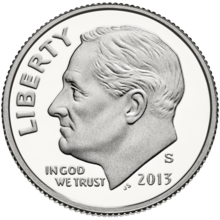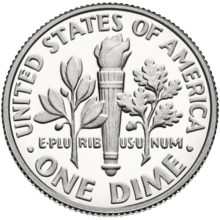
Back دايم (نقود أمريكية) Arabic Dime (moneda) Catalan Dime (Vereinigte Staaten) German Dekcenda monero (Usono) Esperanto Moneda de 10 centavos de Estados Unidos Spanish دایم (سکه ایالات متحده آمریکا) Persian Pièce d'un dime de dollar américain French דיים (מטבע אמריקני) HE डाइम (अमेरिकी सिक्का) Hindi Dime (Egyesült Államok) Hungarian
United States | |
| Value | 0.10 U.S. dollar |
|---|---|
| Mass | 2.268 g (0.0729 troy oz) |
| Diameter | 17.91 mm (0.705 in) |
| Thickness | 1.35 mm (0.053 in) |
| Edge | 118 reeds |
| Composition | Current—91.67% copper, 8.33% nickel Prior to 1965—90% silver, 10% copper |
| Years of minting | 1796–1798, 1800–1805, 1807, 1809, 1811, 1814, 1820–1825, 1827–1931, 1934–present |
| Catalog number | – |
| Obverse | |
 | |
| Design | Franklin D. Roosevelt |
| Designer | John R. Sinnock |
| Design date | 1946 |
| Reverse | |
 | |
| Design | Olive branch, torch, oak branch |
| Designer | John R. Sinnock |
| Design date | 1946 |
The dime, in United States usage, is a ten-cent coin, one tenth of a United States dollar, labeled formally as "one dime". The denomination was first authorized by the Coinage Act of 1792.
The dime is the smallest in diameter and is the thinnest of all U.S. coins currently minted for circulation, being 0.705 inches (17.91 millimeters) in diameter and 0.053 in (1.35 mm) in thickness. The obverse of the current dime depicts the profile of President Franklin D. Roosevelt and the reverse has an olive branch, a torch, and an oak branch, from left to right respectively.
The word dime comes from the Old French disme (Modern French dîme), meaning "tithe" or "tenth part", from the Latin decima [pars].[1] The dime is currently the only United States coin in general circulation that is not denominated in terms of dollars or cents. As of 2011[update], the dime cost 5.65 cents to produce.[2]
- ^ Dime. Webster's Encyclopedic Unabridged Dictionary of the English Language, 1989.
- ^ "US Mint Coin FAQ". Usmint.gov. Archived from the original on 2013-06-18. Retrieved 2013-04-13.